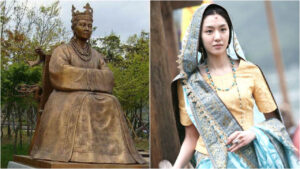News Desk, Kolkata : In the sacred precincts of Ayodhya, a momentous event unfolded as the divine consecration of Ramalala at the Ram Mandir marked a grand union. Bathed in the luminosity of flowers and light, Ayodhya awakened on this day. The trustees of the Ram Mandir extended invitations to representatives from over 50 countries, including a special envoy from South Korea, Kim Chil-su.
Kim Chil-su, hailing from the illustrious Karak dynasty, traced its roots back to King Suro and Queen Heo. Legend has it that around 42 AD, King Suro founded the Karak dynasty, and in 48 AD, Queen Suriratna, daughter of Ayodhya, embarked on a three-month sea voyage to marry the king of a distant land – Korea. This historical connection weaves a narrative that echoes through time.

The tale unfolds further in the dream of Queen Suriratna’s parents in 48 AD. In a divine vision, they were instructed by the gods to send their daughter to Gaya in South Korea. Struggling to find a suitable match for their princess, they loaded her with gifts, servants, and set sail on a ship destined for Korea. After a three-month maritime journey, Suriratna reached her destination and eventually married King Suro. The dynasty, known as Karak, thrived for over 562 years.
The legacy of Suriratna lived on, and in South Korea, the descendants proudly identify themselves as members of the Karak lineage. Notably, former presidents like Kim Dae-jung and Prime Ministers like Hwang In-kil and Chung Pil-kyun are part of this dynasty. The reverence for their heritage is evident as some ancient stones from Ayodhya are preserved in Korea. Locals believe that during Suriratna’s sea journey, these stones balanced the ship, and as a result, they hold spiritual significance.
The story echoes not only in Korea but resonates across borders. Prime Minister Narendra Modi even acknowledged this historic connection during his tenure. The First Lady of South Korea, Kim Jung-sook, received an invitation to the Deepavali celebrations in Ayodhya in 2018, where she adorned traditional Indian attire, embracing the cultural ties between Ayodhya and Korea.
The ties go beyond recent events. In 1996, a delegation from Korea’s Inje University came to Ayodhya to trace the roots of Queen Heo’s lineage. The representative team connected with members of Ayodhya’s royal family, leaving a lasting impression. In 1999, Bimlendra Mohan Pratap Mishra, a current scion of Ayodhya’s royal family, received the highest honors in Korea during his visit to the capital.
The enchanting narrative unfolds not only through historical events but also through personal encounters. In 1996, a delegation from Korea’s Inje University came to Ayodhya to trace Queen Heo’s lineage. The representatives immersed themselves in the cultural heritage of Ayodhya and met with members of the royal family.
Fast forward to 1999, Bimlendra Mohan Pratap Mishra, a distinguished member of Ayodhya’s current generation, was honored in Korea during his visit to the capital. The warmth of the reception highlighted the enduring bond between Ayodhya and Korea.
The tale takes a contemporary turn as well. In 2018, the First Lady of South Korea, Kim Jung-sook, graced Ayodhya’s Deepavali celebrations, donning traditional Indian attire. Beyond the diplomatic gestures, her genuine engagement with the local youth reflected the profound impact of cultural exchanges.
This historical saga resonates not just in the pages of textbooks but is etched in the hearts of people on both sides. The intertwined destinies of Ayodhya and Korea span centuries, blending myths, dreams, and diplomatic ties into a rich tapestry that continues to captivate imaginations.
DISCLAIMER
Our news media denounces any form of bias and disapproves of sensationalism. The disseminated news is entirely educational and aimed at social awareness. Our media maintains absolute impartiality, adhering solely to the purpose of education and social consciousness.